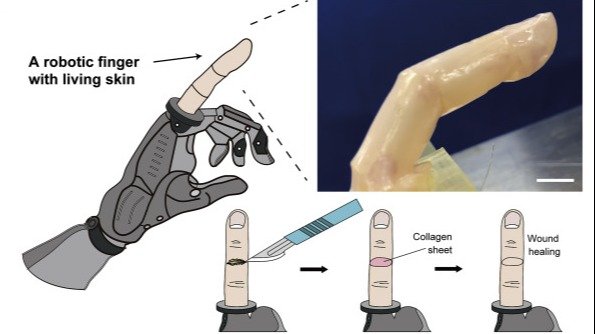At this point, we’re all pretty much resigned to the fact that someday, some way, robot overlords will rule the earth .
While it’s true that humanity has made great strides in the field of robotics, so far it’s all been done in the name of good rather than evil (well, there are exceptions ).
One recent development, announced by roboticists from the University of Tokyo, deals with putting skin — real, honest-to-goodness human skin — on an articulated robot finger.
There are more than a few things that set robots apart from humans.

The processing power of a robotic CPU versus the processing power of a human brain is its own issue that we’ll put aside for the moment.
One of the biggest differences between a human and a robot pretending to be a human, at least at face value, is the uncanny valley effect. A robotic automation may be impressive, but it replicates, rather than duplicates, human features like hair, eyes, and skin.
Roboticists have put human skin on robot fingers.

Scientists — I promise not to call them ‘mad scientists’ — from the University of Tokyo have found a better material than rubber or silicone for replicating human skin. That material, perhaps unsurprisingly, is…human skin.
It’s more difficult than you might think.

It’s fairly easy to grow human skin in a lab environment — that’s how skin grafts are sometimes created . But it isn’t a simple matter of growing skin and slapping it on a robotic frame, because it doesn’t take into account the flexing that natural skin does.
In short, there are seams in the lab-grown, robot-grafted skin that don’t play nice with flexing and movement.
Roboticists created a simple finger with three moving joints.

For the record, that’s a finger and just a finger, so get your mind out of the gutter.
Researchers took the robotic finger and submerged it in a mixture of structural proteins and cells found in the skin’s connective tissue. Once the finger was thoroughly soaked, the solution wrapped itself around the robotic finger, which created a layer that which the actual skin could be applied.
The finger was then covered with epidermal keratinocytes.

Epidermal keratinocytes are the main type of cells found in the skin’s outer layer. Once they’d been applied to the finger (which, remember, had been coated in a blend of structural proteins and connective cells), the finger looked decidedly human. More importantly, it could withstand flexing and bending.
The skin is completely waterproof.

This shouldn’t be too surprising, as human skin is also waterproof. But it’s a major step, as the unique methods used by the scientists eliminated the gaps or seams that water might otherwise find its way into. Just as our skin keeps the elements out of our insides, the robotic skin keeps the elements out of the electronic workings of the robotic finger.
The robot skin can even heal itself.

Because the robotic skin is actual living skin, it can also heal itself. Scientists damaged the skin to see what would happen and, sure enough, it healed right up after being treated with a bandage made of collagen.
It’s a big step in the field of robotics.

Creating humanoid robots is a bit of a puzzle, incorporating not just raw computing power, but also things like machine learning and physical traits. Needless to say, there’s a lot of work and research still to be done. But thanks to the research of these roboticists, we’re one step closer to creating a robot with realistic human skin.
Depending on where you sit on the matter, this is either incredibly exciting or deeply creepy.
Are you ready to accept our robot overlords?

I kid, I kid. We’re at least a few years away from the big robotic uprising.
That said, advancements in the field continue to accelerate. What do you think of this? In an ideal world, how should robots be utilized? And once they’re utilized, do you want them to have human skin? These are the big questions we’d love to have answered, so please share your thoughts in the comments section.
h/t: Matter | Cell.com

















































